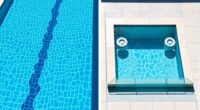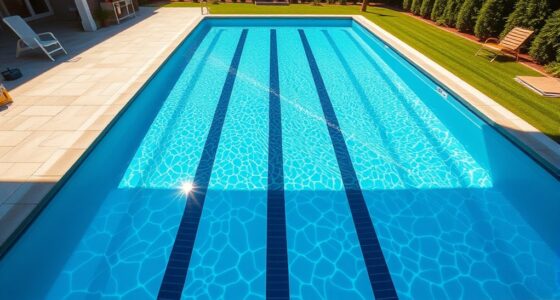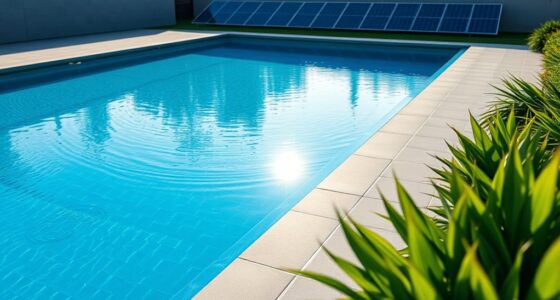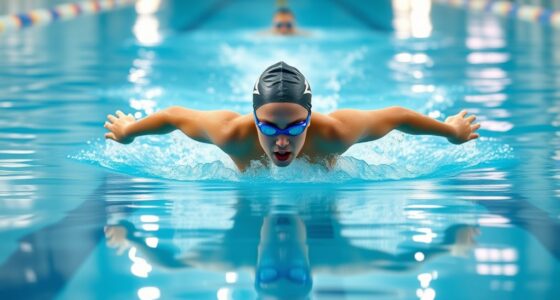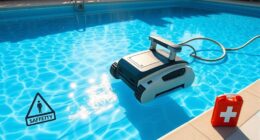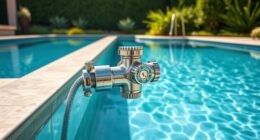To improve endurance in a 10-lap pool, alternate high-intensity sprints with steady swims, gradually increasing effort and reducing rest. Mix different strokes like freestyle, breaststroke, and butterfly to engage various muscles. Try swim sets such as 50 meters fast, then 50 meters easy, and progressively extend your high-effort intervals. Incorporate longer swims and reduce recovery times over time. Keep challenging yourself, and you’re on your way to building lasting stamina—stick with it to learn even more effective strategies.
Key Takeaways
- Incorporate interval training by swimming 50-100 meters fast, then recovering, to boost stamina gradually.
- Mix different strokes like freestyle, breaststroke, and butterfly to target various muscle groups and prevent plateaus.
- Gradually increase high-effort interval durations from 30 to 60 seconds while reducing rest periods over time.
- Include both anaerobic sprints and steady-paced swims within your workout for comprehensive endurance building.
- Track progress and adjust intensity or recovery times regularly to ensure continuous endurance improvement.

A lap pool offers a versatile environment for effective workouts, whether you’re aiming to improve endurance, build strength, or burn calories. If your goal is to increase stamina, focusing on the right techniques and incorporating interval training benefits can make a significant difference. Building endurance isn’t just about swimming longer; it’s about training smarter, pushing your limits gradually, and giving your body the stimulus it needs to grow stronger.
A lap pool is ideal for boosting endurance through smart training and interval techniques.
One of the most effective ways to increase stamina is to implement interval training. This involves alternating between high-intensity swimming and recovery periods. For example, swim at a fast pace for 50 to 100 meters, then slow down for the same distance or a little longer to recover. Repeating this cycle multiple times trains your cardiovascular system to handle increased workloads and helps you swim longer distances with less fatigue over time. Interval training benefits include improved heart efficiency, enhanced lung capacity, and increased muscular endurance—all vital for boosting stamina.
To get the most out of your workouts, you should vary your techniques and intensities regularly. For instance, incorporate different strokes like freestyle, breaststroke, and butterfly into your interval sessions. Each stroke targets different muscle groups and challenges your body in unique ways, helping you develop a well-rounded endurance base. Additionally, try mixing sprint sets with steady-paced swimming. Sprint sets push your anaerobic threshold, forcing your body to adapt to more intense efforts, while steady-state swims build your aerobic capacity.
Another key to increasing stamina with interval training is to gradually increase the intensity and duration of your high-effort periods. If you’re starting, swim at a fast pace for 30 seconds, then recover for 30 to 60 seconds. Over time, extend the sprint intervals to 45 or 60 seconds, and reduce your rest periods. This progression forces your body to adapt continuously, leading to improved endurance. Remember, consistency is essential—regularly challenging yourself with these techniques guarantees steady progress.
Finally, complement your interval training with proper recovery and cross-training. Rest days allow your muscles to repair and grow stronger, while cross-training activities like running or cycling can enhance your cardiovascular fitness further. Utilizing advanced equipment such as heart rate monitors can help you optimize your workout intensity and track your progress accurately. By combining these strategies, you’ll see your stamina improve, enabling you to swim longer distances with greater ease and efficiency. The key is to stay committed, listen to your body, and keep pushing your limits with well-structured workouts that leverage the benefits of interval training.
Frequently Asked Questions
What Is the Optimal Lap Pool Workout Frequency for Endurance?
To improve endurance, you should aim for consistent training, ideally swimming 3 to 4 times a week. This frequency allows you to build stamina without overtraining. Incorporate workout variation, such as different strokes and interval training, to prevent plateaus and keep your workouts engaging. Stay committed to your schedule, and you’ll gradually see your endurance improve. Remember, steady training consistency is key to long-term progress.
How Can I Prevent Injuries During Lap Pool Workouts?
Imagine gliding through smooth water, feeling your muscles warm and ready. To prevent injuries, focus on proper swimming technique and don’t skip warm-up routines. Start slow, gradually increasing intensity, and pay attention to your body’s signals. Strengthen muscles with cross-training, and stay hydrated. With mindful practice, you’ll enjoy injury-free laps, building endurance while feeling confident in each stroke.
What Equipment Can Enhance My Lap Pool Endurance Training?
To boost your lap pool endurance, you can use swimming aids like kickboards and pull buoys to target specific muscles and improve technique. Resistance tools such as hand paddles and resistance gloves add extra challenge, helping you build strength and stamina. Incorporating these equipment pieces into your routine makes workouts more effective, allowing you to swim longer distances with less fatigue. Just guarantee you use them correctly to prevent injuries.
Are There Specific Lap Pool Workouts Suitable for Beginners?
Imagine transforming your swim game overnight—sounds impossible, right? But with beginner-friendly routines, you can start today! Focus on simple swim drills like steady laps, kickboards, and easy intervals. These workouts build confidence and endurance without overwhelming you. Keep it consistent, and soon you’ll be swimming stronger, faster, and more effortlessly. Don’t wait—dive into these beginner-friendly routines and watch your skills soar!
How Should I Adjust My Diet to Support Endurance Swimming?
To support endurance swimming, you should focus on nutrition planning that fuels your workouts and aids recovery. Prioritize carbohydrate-rich meals before training to boost energy, and include protein afterward to repair muscles. Pay attention to meal timing; eat a balanced meal 1-2 hours before swimming and hydrate well. Incorporate healthy fats and snacks as needed to maintain energy levels throughout your sessions. Consistent fueling helps improve endurance and overall performance.
Conclusion
Immerse yourself in these lap pool workouts and watch your endurance bloom like a vibrant garden in spring. Each stroke is a stepping stone across a sparkling river of progress, guiding you toward stronger, more resilient swimming. Embrace the rhythm of your strokes and feel the water carry you forward, carving out a path to your best self. With dedication, you’ll soon be dancing through the water like a fish in its favorite stream.

